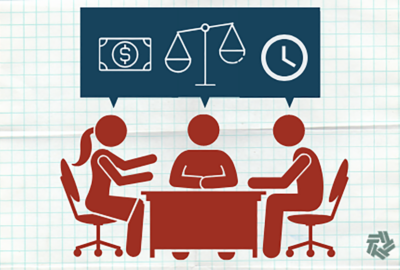2022 Best Places to Work results are a ‘warning signal’ for agency leaders
The 1.1-point decrease on the employee engagement and satisfaction index indicates many agencies are still struggling with challenges like return-to-office...
For 2022, employee engagement and satisfaction results in the Best Places to Work in the Federal Government came not with a bang, but a whimper.
After taking a massive 4.5-point hit in 2021, the governmentwide employee engagement and satisfaction score in the Partnership for Public Service’s annual rankings slipped yet again — this time decreasing by 1.1 points, now down to 63.4 out of 100.
And engagement wasn’t the only area where employees reported declines. Workforce measurements including feds’ perceptions of leadership, work-life balance and innovation also showed poorer results in the Partnership’s analysis this year.
The rankings indicate that many agencies are still struggling with challenges like return-to-office uncertainty, said Max Stier, president and CEO of the Partnership, which in tandem with the Boston Consulting Group, released the full 2022 rankings list Wednesday.
“It’s not just this year. It’s the fact that this is two years running,” Stier said in an interview with Federal News Network. “It was a much more consequential drop last year, but we’re going in the wrong direction.”
In the rankings themselves, not surprisingly, NASA maintained its number one spot for the 11th year in a row. The Government Accountability Office once again took first place for midsize agencies, while the Congressional Budget Office ranked first for small agencies, and the Pension Benefit and Guaranty Corporation’s Office of Negotiations and Restructuring was at the top for agency subcomponents.
The rankings are based on the results of the Office of Personnel Management’s 2022 Federal Employee Viewpoint Survey (FEVS), which showed a governmentwide employee engagement index score of 71 out of 100. It’s the same score as 2021, but a 1-point drop since 2020.
Overall trends for agencies
Beyond the Partnership’s unveiling earlier this month of the top 10 agencies in the 2022 rankings, the release of the full list and other performance trends reveals more problem areas — and questions needing answers — for federal agencies.
“Even those that were on top still largely saw declines at the large agency level,” Stier said.
Of the 17 large agencies in the rankings, just four — the departments of Transportation, Air Force, Army and Agriculture — saw increasing engagement and satisfaction scores from employees.
Overall, just 19 of 74 agencies either increased or held steady in their Best Places to Work index scores for 2022.
For midsize and small agencies, a relatively larger portion had increasing scores, but even top-ranked places like the Government Accountability Office and the National Science Foundation still saw slumping numbers. Notably, one-quarter of agency subcomponents increased their engagement and satisfaction scores.
Regardless of where an agency falls in the rankings, it’s equally, if not more important, to look at internal agency trends over time for employee satisfaction scores, federal human capital leaders have said. Looking more closely at the engagement and satisfaction trends of individual agencies reveals a clearer picture of areas where agencies are struggling, as well as areas of success.
“If you’re an individual leader responsible for a single agency, you absolutely should be looking at the [internal] trend line,” Stier said. “No one should feel like they can rest on their laurels just because they’re at the top or give up because they’re at the bottom.”
Almost since the Partnership’s rankings began in 2003, the Department of Homeland Security has consistently come in last place for large agencies. But for 2022, the Social Security Administration took the bottom spot, paired with a 6-point decrease on the engagement and satisfaction index, dropping from 59.9 to 53.9.
The drop for SSA comes as federal union leaders are warning agency leaders about unmanageable workloads and massive staff attrition among their workforce.
Scores for the departments of Justice and Commerce also dropped significantly, with 3.9-point and 3.1-point declines, respectively. Although it ranked number five overall, the Federal Energy Regulatory Commission’s score dropped 3.8 points.
Looking at the rankings themselves holds value for agencies, particularly when it comes to recruitment and retention, an area of traditional struggle for the federal government.
“No agency operates within a talent vacuum,” Stier said. “I think it’s very important to benchmark yourself against your peer agencies, and also against the private sector, because the federal government isn’t — even though it sometimes behaves this way — an isolated island. It exists within the larger framework of a national labor market. And private sector actors are competing for the best talent against the federal agencies.”
Employee perceptions on federal pay, leadership
Beyond the rankings and engagement score trends over multiple years, the Partnership also measures performance categories, looking at feds’ perceptions on pay, innovation, work-life balance, effective leadership and much more.
For 2022, the scores from federal employees in many of these areas were generally on the decline.
For leadership, which measures the performance of supervisors, managers and senior leaders, the overall category received a score of 67.3 out of 100, a 0.7-point decline since 2021.
The leadership empowerment category, a measure of how much employees feel empowered at work and how much they feel involved in decisions affecting their work, had the lowest score of all the leadership trends that the Partnership tracks. The category had a score of 50 out of 100, 5.7 points below the score in 2021.
“For leaders to understand how to turn this around, part of it is by really giving their workforce both the skills and investment necessary to do their jobs well, and the autonomy to do what they can do,” Stier said.
Immediate supervisors typically receive higher scores than senior leaders from employees, and for 2022 that trend was no different. But the senior leadership score was 55.3, nearly 25 points below that of immediate supervisors, and a much starker contrast than in recent years.
“It may be that you will always have, or most always have, better perception of your frontline supervisor. But there’s a lot of room for improvement for senior leaders,” Stier said.
Notably, federal employees’ pay satisfaction index had the biggest drop of all the performance categories, going from 61.2 to 55.9, or a 5.3-point decline.
Like everyone else, federal employees experienced high inflation around the time the data was being collected, Stier said, which likely contributed to the poor results.
“For federal employees, what’s a little different is that they experienced the impact [of inflation] themselves directly,” Stier said. “Many of them are on the front lines of trying to deal with the problem itself.”
Uncertainty over agencies’ return-to-office also continued to have a negative impact on the results, the Partnership said. Clear and direct communication in these cases is key and would likely help struggling agencies improve their scores.
“Uncertainty causes oftentimes more harm than answers that are unpleasant, but at least are known,” Stier said.
Some agencies stand out in a good way
Despite declining results in the Partnership’s 2022 rankings, some agencies still shone through.
USDA had the biggest score increase for large agencies this year, improving by 1 point and moving up two slots in the overall rankings.
The Department of Veterans Affairs maintained a steady score this year and kept its number five slot for large agencies. Just five years ago, VA was in the lowest quartile overall, the Partnership said.
The Small Business Administration, a midsize agency, had a 5.9-point increase in its engagement and satisfaction score.
The Federal Election Commission was the most improved small agency, increasing its score by 4.8 points.
“Oftentimes, people look at the broken elements of things. Frankly, more progress can be made on building on your strengths,” Stier said. “Even in organizations that are seeing declines, my bet is they have components that are bucking the trend and that are going up. I’d be paying attention to what the leadership is doing in those components.”
On the agency subcomponent list, the Field Service of the Railroad Retirement Board moved up 74 spots, from 428 in 2021 to 354 in 2022 — and improved its score by 13.7 points, the largest increase of any agency in the rankings.
“That tells you that good leaders can overcome difficult environments,” Stier said. “I think the consistent lesson for all of us is, you need leaders who first and foremost care. Understand that this is a fundamental part of their job — create environments that engage their employees and prioritize them.”
Rankings by employee demographics
Many factors that the Partnership considered in the rankings this year built on new components from the 2022 FEVS. Perhaps most notably, OPM added a new index in the governmentwide survey to assess employees’ perceptions of how well their agencies are incorporating diversity, equity, inclusion and accessibility initiatives.
Despite an overall DEIA index score of 69 out of 100 in FEVS, there is significant contrast in the results when looking by specific workforce demographics.
“The overall DEIA score for white employees (72.6) is 4.4 points higher than the score for people of color (68.2),” the Partnership said in a press release Wednesday. “The same disparity exists for LGBTQ+ employees (63.1) and employees with disabilities (64.2).”
In all other workforce categories, white individuals and people of color have comparable scores, the Partnership said.
In terms of age, employees between 30 and 39 had the lowest engagement and satisfaction score for 2022, 3.9 points below the overall 63.4 score. On the other hand, employees 60 and older have the highest scores for most workforce categories of any age group in the federal workforce.
One area of acute concern for the Partnership, though, was how employees felt about “mission match,” or whether employees felt their agency and job description aligned with their personal career goals. Employees under age 30 scored the lowest of any age group for this category.
The sharp 4.5-point drop in the 2021 rankings left many leaders saying last year that the federal government was at an “inflection point” with the future of its workforce. But the continuing trend downward in 2022 is a warning sign for agency leaders, the Partnership said.
Of course, the solution is much easier said than done, Stier said.
“I think the message for leaders in the Biden administration is that they have more to do — they need to step up,” Stier said. “That’s their responsibility — to deliver services to the public effectively. Having an engaged workforce is fundamental in the ability to succeed in doing that.”
Copyright © 2025 Federal News Network. All rights reserved. This website is not intended for users located within the European Economic Area.
Drew Friedman is a workforce, pay and benefits reporter for Federal News Network.
Follow @dfriedmanWFED





